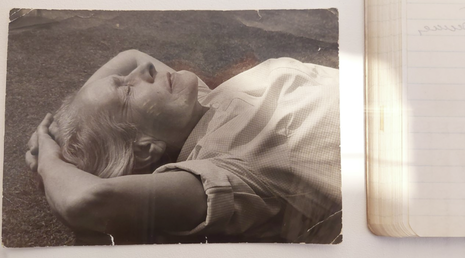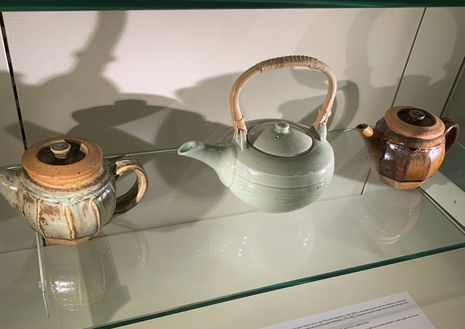‘Salt crystals on a shrinking sea’: Lucie Rie’s pottery is always in motion
Arts Writer Anna Wythe reviews a new Kettle’s Yard exhibition showcasing the striking, primal works of Lucie Rie

On a particularly phlegmatic Friday morning, all I wanted to do was stay in bed with my Lemsip and my misanthropy. I hadn’t heard of Lucie Rie, and my most common thought about ceramic objects was how much coffee I could fit inside them. Suffice to say, I was in no mood for pots as I lurked among the London art critics, air-kissing in Kettle’s Yard foyer.
The Lucie Rie exhibition, however, was not pottery as I knew it. I had thought a pot was something static, but Rie had the strange ability to transfix motion. The white and turquoise glaze on the first piece I saw recalled salt crystal deposits of a shrinking sea. As I looked closer, parts of the blue would swirl suddenly like currents in the sea itself.
Rie’s work often appears to be the outcome of gradual organic or geological processes. There were echoes of birch tree bark, lichen on granite, rust, the pores of pumice stone and even the breast of a sparrow. One of her pots seemed to have grown like coral, while a few pale pieces with black speckling might have emerged suddenly from the earth like giant mushrooms.
“Rie’s work often appears to be the outcome of gradual organic or geological processes”
Lucie Rie was clearly a vulcanist. She wasn’t just glazing pots; she was unleashing potent chemical reactions that fizzed and bubbled in the kiln’s heat. A wonderful documentary, filmed while she was alive and screened at the exhibition, shows her at work mixing the glazes with an air both of precision and abandon. When a young David Attenborough asks how many ingredients she puts in each, she snaps impatiently: “As many as necessary.”
On screen, Rie is very much to-the-point. A slight figure with white hair and a blue apron, she is a craftswoman as much as an artist. Indeed, her work often has that brilliant duality of being functional and still never reduced to function. She sold her tea and coffee sets to department stores and made buttons when rationing prohibited her pottery. It seemed to me that her work’s presence in ordinary acts, such as drinking coffee or wearing a coat, would not lessen its “artistry”. Rather, it would bring a near-ritualistic seriousness and joy into the otherwise mundane.
I repeatedly found myself thinking that there was something mystical about Rie’s pottery. From the coppery glow of her manganese glazes to the totemic feel of the buttons, I had the distinct sense that her work would help me ward off evil spirits just as it had banished my unpleasant mood. And yet Rie was no hippie witch. She was inspired by ancient Roman pottery but also by her contemporaries. Culturally, she was the heir both to the Bauhaus movement and to Viennese Secession. Indeed, she puts paid to clumsy dichotomies when she reminds us that “art alive is always modern, no matter how young or old.”
“I had the distinct sense that her work would help me ward off evil spirits”
For me, that is what elevates the Lucie Rie exhibition above simply the good or beautiful. She does not simply combine the ancient and the modern. Instead, the features that bring her work a sense of ancient enchantment are also what make it distinctively modern. Her sgraffito technique was inspired by the white lines scratched with bird bones into prehistoric pots. Yet in one of her pieces from 1957, these white lines become so tightly enmeshed that they seem almost an optical illusion: an Escher-like space in flux.
I thought about the way an iron suspension bridge can hold the same deep force as the river that flows beneath it. The modernity of Rie’s work is resplendent rather than harsh, clear rather than murky. Perhaps the secret to this lies in her colours, from stark black and white to something she called “American yellow”, but of course, it’s also inseparable from the forms: the conical bowls and the fluting lips atop slender bottles like crested cranes. Rie took up the prehistoric as delicate and the modern as darkly charismatic. The primal chemistry of her glazes spat in the exacting heat of an electrical kiln.
Lucie Rie lived almost the entire length of the 20th century. Indeed, as a young woman she fled Vienna during the Nazi takeover. The rest of her life was spent in England, most of it in her small studio. She was a quieter sort of historical figure, practising a subtler alchemy than the vast atomic explosions of the previous century. She left me thinking of the seriousness of devoting one’s life to a craft, of choosing to participate in the world through a particular, and indeed remarkable, set of objects.
The Lucie Rie exhibition is at Kettle’s Yard until 25 June, open 11am–5pm.
 News / Caius mourns its tree-mendous loss23 December 2025
News / Caius mourns its tree-mendous loss23 December 2025 Comment / Yes, I’m brown – but I have more important things to say22 December 2025
Comment / Yes, I’m brown – but I have more important things to say22 December 2025 News / Clare Hall spent over £500k opposing busway 24 December 2025
News / Clare Hall spent over £500k opposing busway 24 December 2025 Interviews / Politics, your own way: Tilly Middlehurst on speaking out21 December 2025
Interviews / Politics, your own way: Tilly Middlehurst on speaking out21 December 2025 News / King appoints Peterhouse chaplain to Westminster Abbey22 December 2025
News / King appoints Peterhouse chaplain to Westminster Abbey22 December 2025









